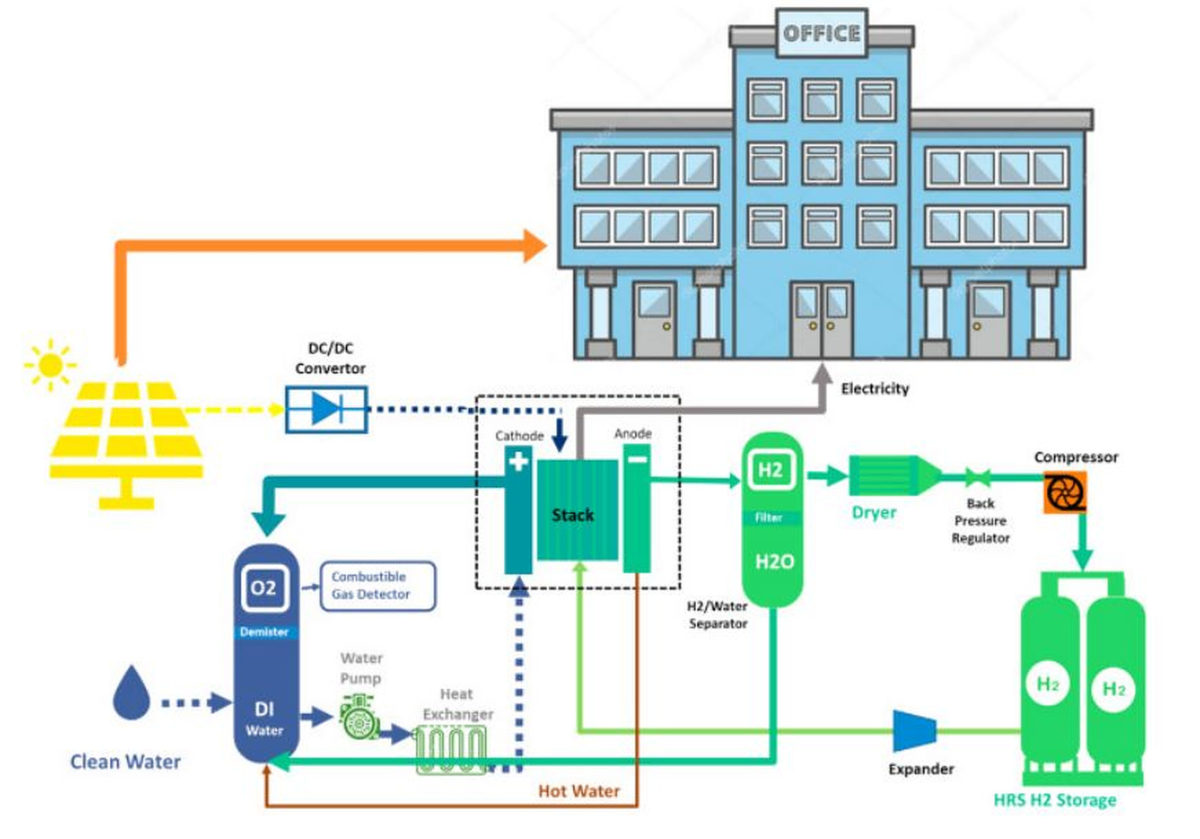Researchers from Khalifa University in the United Arab Emirates have conducted a techno-economic analysis of a building energy system based on standalone rooftop PV linked to either lithium-ion batteries, proton-exchange membranes reversible fuel cells (PEM RFC), or reversible solid oxide cells (RSOC). They have found that each of the proposed configurations could result in low capital costs and high efficiency.
The scientists quantified the impact of the PEM RFC and RSOC on overall system degradation. Their modeling considered a typical medium-sized commercial building in Los Angeles, California. Its minimum value of electricity demand was 18.79 kW during the night, with a maximum demand of 178.30 kW in August. The rooftop solar array was assumed to have a capacity of 400 kW, with 310.15 W SPR-E19-310-COM solar modules with 19% efficiency from US manufacturer SunPower.
The 250 kW RSOC system – equipped with an air preheater, water boiler, and high-performance heat exchangers – was assumed to have a power density of 0.312 W and an overall system efficiency of 43.99. The fuel cell has a capacity of 251.4 kW, a power density of 0.284 W, with a total system efficiency of 38.18%.
The cost of the RFC was estimated at around $667/kW and that of the RSOC at $500/kW. The costs were based on a modeled 250 kW PEM stack cost and 250 kW RSOC stack cost, at 10,000 units per year. The battery is based on a nickel-manganese-cobalt cathode and graphite anode, and has a storage capacity of 400 kWh. It has a round-trip efficiency of 92.5% and a cost of $339/kW. Its lifetime is more than 5,000 cycles.
The academics found that the PV system can achieve a levelized cost of energy (LCOE) of $0.0237/kWh. The levelized cost of storage (LCOS) of the RFC, RSOC and the battery was $0.04173/kWh, $0.02818/kWh, and 0.02585/kWh, respectively.
“The breakdown of the LCOS shows that capital cost accounts for more than 65% of the total LCOS, making it the most important component that needs more R&D to bring the capital cost down for these energy storage technologies,” they explained.
Popular content
They found that the LCOS increases and the discharge decrease depended on the lifetime of each of the three storage technologies they used.
“The LCOS is sensitive to changes in capital costs, round-trip efficiency, lifetime, and discount rate; therefore, changes in these parameters should be carefully considered,” they warned, noting that lithium-ion batteries offer the most economical solution along with maximum efficiency, while also noting that RFCs and RSOCs can improve a standalone building's reliability and resiliency.
The scientists presented their findings in “Techno-economic analysis of energy storage systems using reversible fuel cells and rechargeable batteries in green buildings,” which was recently published in Energy.
*The article has been amended on May 24 to reflect that the total system efficiency is 38.18% and not 31.18%, as we previously reported.
This content is protected by copyright and may not be reused. If you want to cooperate with us and would like to reuse some of our content, please contact: editors@pv-magazine.com.



The one parameter that is not considered is safety. The hydrogen systems are significantly safer than Li battery. The most probable failure of H2 is leakage which can escape extremely fast into a vent and outer space. Li batteries on the other hand can be subjected to spontaneous combustion of a faulty cell and can burn without the ability to stop the fire.
“The fuel cell […] with a total system efficiency of 31.18%” -> when I take a look at the linked original report, I find a “Total System Efficiency of 38.18%”. Where does this difference come from or is it a typo in the article here?
thanks for your message Garvin, you are right there was a typo in reporting that number. The article has been amended.
Thank you very much for sharing our research results, Emiliano. It is indeed an immense honor to see the effort we put into this research recognized. My advisor and I have been working on Energy Storage Systems for around 2 years now, and the more we do research about it, the more astonished we are with how limitless some novel technologies are.